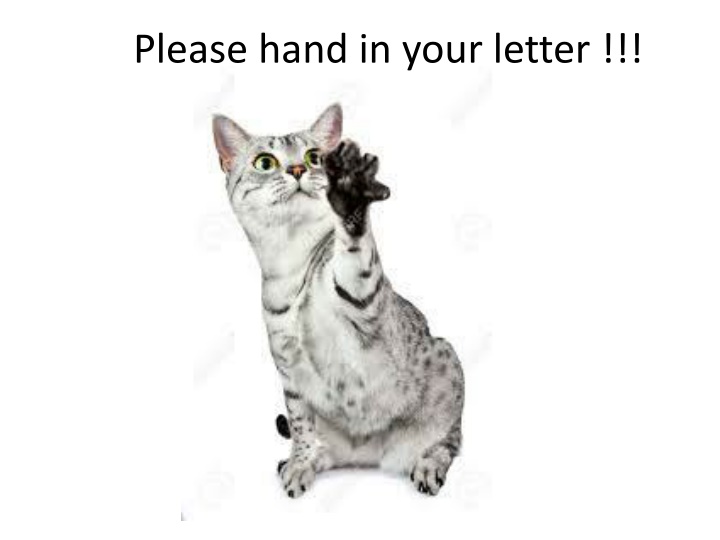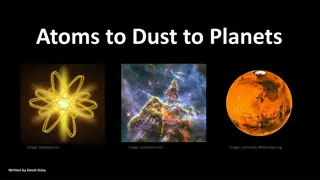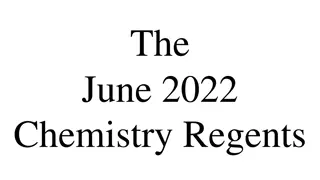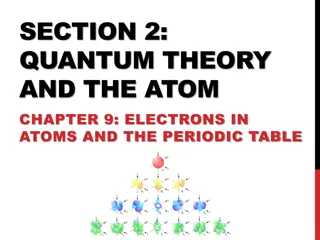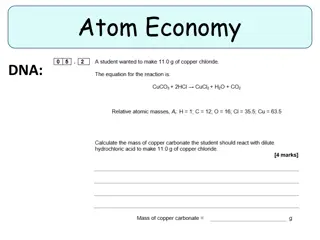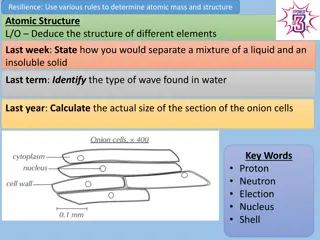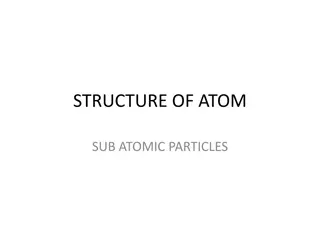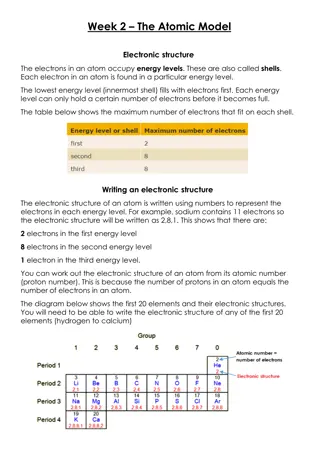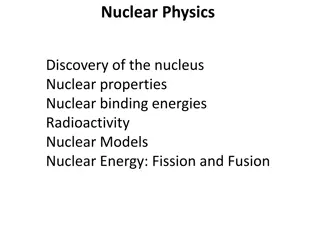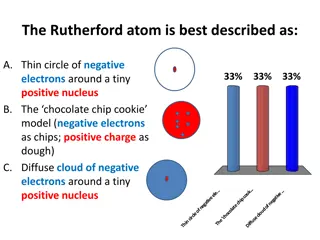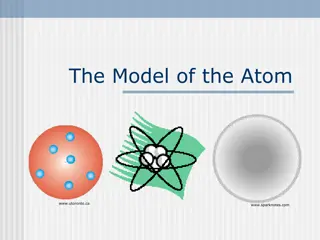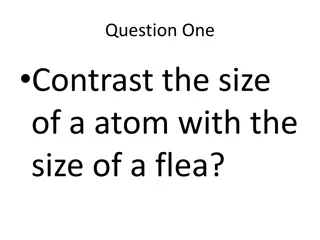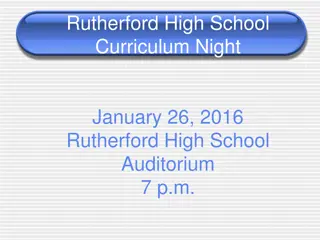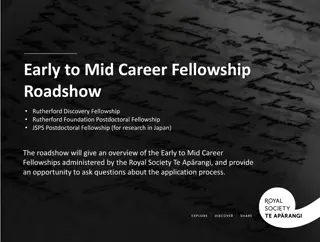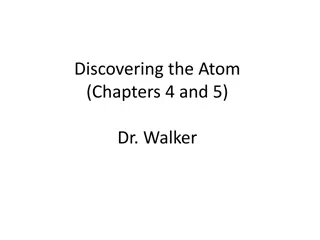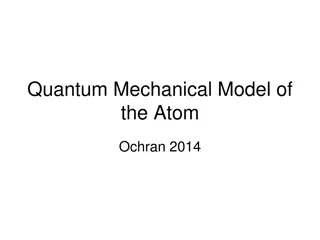Unveiling Rutherford's Atom: A Journey into Subatomic Dimensions
Delve into the groundbreaking experiments of Rutherford's gold foil apparatus and the Gold Leaf Experiment, revealing the structure of atoms with subatomic particles like protons, neutrons, and electrons. Explore the dimensions of the electron cloud and nucleus through vivid chemical metaphors, providing a fascinating insight into the fundamental building blocks of matter.
Download Presentation

Please find below an Image/Link to download the presentation.
The content on the website is provided AS IS for your information and personal use only. It may not be sold, licensed, or shared on other websites without obtaining consent from the author.If you encounter any issues during the download, it is possible that the publisher has removed the file from their server.
You are allowed to download the files provided on this website for personal or commercial use, subject to the condition that they are used lawfully. All files are the property of their respective owners.
The content on the website is provided AS IS for your information and personal use only. It may not be sold, licensed, or shared on other websites without obtaining consent from the author.
E N D
Presentation Transcript
Schematic of Rutherfords `gold foil apparatus Microscope Rotated to detect scintillations http://www.antonine-education.co.uk/Image_library/Physics_5/Nuclear_physics/alpha.gif Alpha ( ) particles=He+ ZnS screen is a scintillating surface
The Gold Leaf Experiment led to Rutherfords Atom Nucleus is + charged Electrons (e-) are - charged ~ 10-10 m Diffuse electron Cloud out here ~10-15 m Nucleus contains protons (p+) and neutrons Nucleus at center (magnified here ~10,000X)
Chemical metaphor 1 Atom as .. String and pencil dot
Rutherfords Atom by the numbers Diameter of electron cloud = 10-10 m Diameter of nucleus 10-15 m Do the math Diameter of electron cloud = 100000 Diameter of nucleus 1
Atom dimensions in familiar terms: Metaphor 2 where is the edge of the electron cloud ? 3 Baseball as nucleus Old Yankee Stadium, the Bronx
http://www.aaccessmaps.com/images/maps/us/ny/nyc_area_hwy/nyc_area_hwy.gifhttp://www.aaccessmaps.com/images/maps/us/ny/nyc_area_hwy/nyc_area_hwy.gif Nucleus(+) ~ dimension of electronic cloud (-) (2.4 mile radius from baseball nucleus)
details of Rutherford atoms subatomic pieces Subatomic piece proton neutron electron In neutral atoms # protons = # electrons Relative mass ratio ? Mass (g) 1.67*10-30 1.67*10-30 9.11*10-34 Charge + 0 - 1.67*10-30 9.11*10-34 Proton mass Electron mass = =1836 ~ 2000 Do the math .
Chemical metaphor 3: nuclear vs. electron mass Proton mass Electron mass 1 running back ~ 2000 large eggs
Rutherfords Atom by the numbers (continued) Atomic part Relative volume Nucleus 0.00000000000001 Electrons 1 electron cloud is 99.99999999% of atomic volume but only 0.5% of the mass
Chemical metaphor 4: volume comparison-nucleus vs. electron cloud Volume occupied by nucleus Volume occupied by electrons
Describing elements using the atomic bits and pieces (see p. 10-13) Modern Periodic Table of the Elements: How Chemists List the Elements
Father of Modern Periodic Table: Dimitri Mendeleev ~1865 Chemistry Professor, St. Petersburg University, Russia Dedicated Teacher Known Vodka enthusiast Political troublemaker Card Shark
Analogies (continued) 2) Card player insights GRAPHITE MP 1710 OC d=2.11 g/cm3 BLACK CO, CO2 2 other crystal forms 6C 12.01 Playing card Element card
A brief aside on element names and symbols
1) The proton count is the same as the Periodic Table s Atomic # . Proton count defines the element Atomic # =#p+
2) In a neutral element: positive charge sum = proton count=#p+ = negative charge sum =electron count=#e- #p+ = #e-
How many protons in an Aluminum atom ? A. 26 B. 26.982 C. 13 D. varies 25% 25% 25% 25% 26 13 26.982 varies
How many electrons does neutral Carbon C have ? A.12.01 B. 6 C. 12.01-6 D.12.01 + 6 25% 25% 25% 25% 6 12.01 12.01-6 12.01 + 6
3) Elements come in several `flavors= isotopes =# p+ Aston s Mass Spectrometer ?????? Francis William Aston Cambridge University UK Nobel Prize in Chemistry 1922 What Aston sees in his mass spectrometer when he puts in pure Ne Mass/p 20.0 22.0
22.0 20.0 Mass/p Something else besides protons is in nucleus, but it has no charge. Dubbed a neutron =no. The neutron weighs the same as a proton (Mass/p=whole #) You can have different numbers of no in a given element. (A specific # of no = a specific isotope) =# p+ What Aston s result teach .
How many electrons (e), protons (p) and neutrons (n) in the Ne isotope circled below? 25% 25% 25% 25% A. 10 e 20 p 20 n B. 10 e 12 p 10 n C. 10 e 10 p 22 n D. 10 e 10 p 12 n 10 e 10 p 12 n 10 e 10 p 22 n 10 e 20 p 20 n 10 e 12 p 10 n 20.0 22.0 22.0 Mass/p
How the entries on the Modern Periodic Table reflect the `Modern definition of an element proton count Average mass of protons and neutrons
Representing Elements with Atomic symbols p = atomic number (Z) defines element p + n = mass number=M (several choices for an element) p = e in neutral atom Isotope = element with specific count of n M Z How to represent an isotope p
